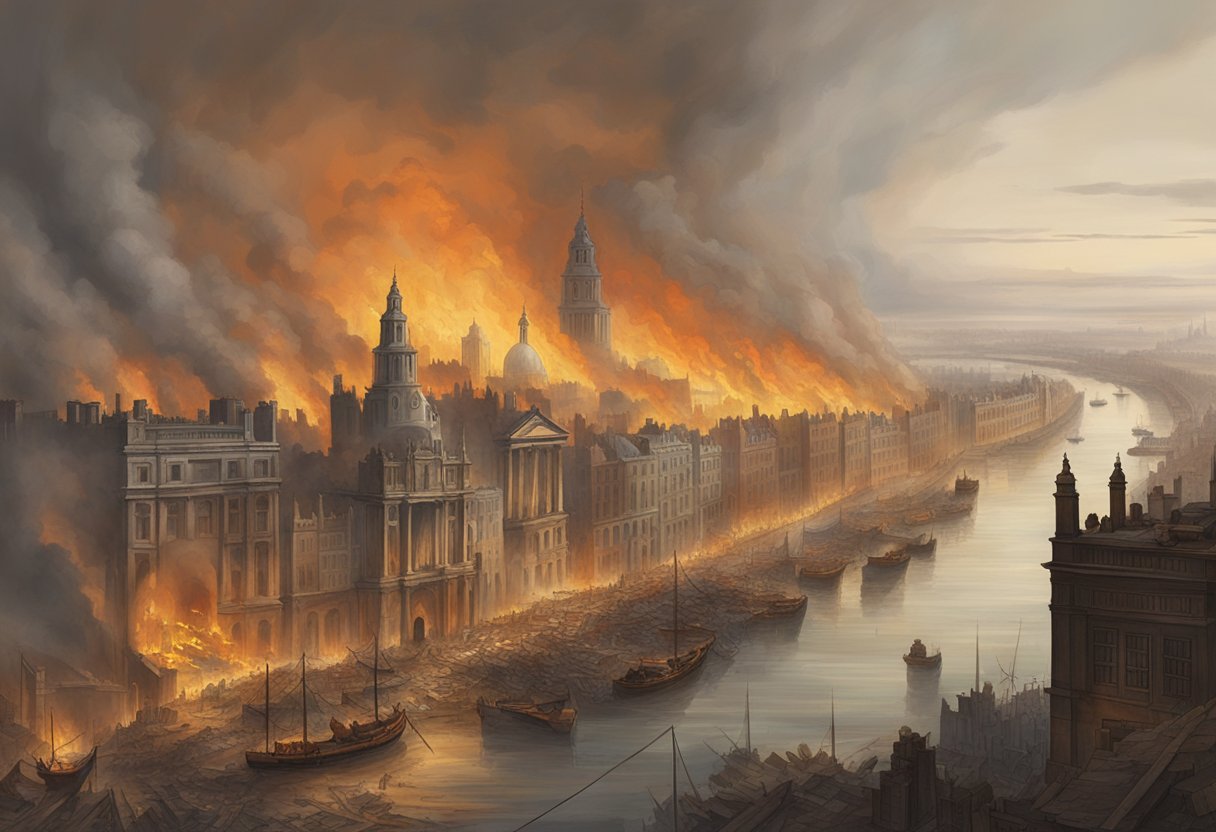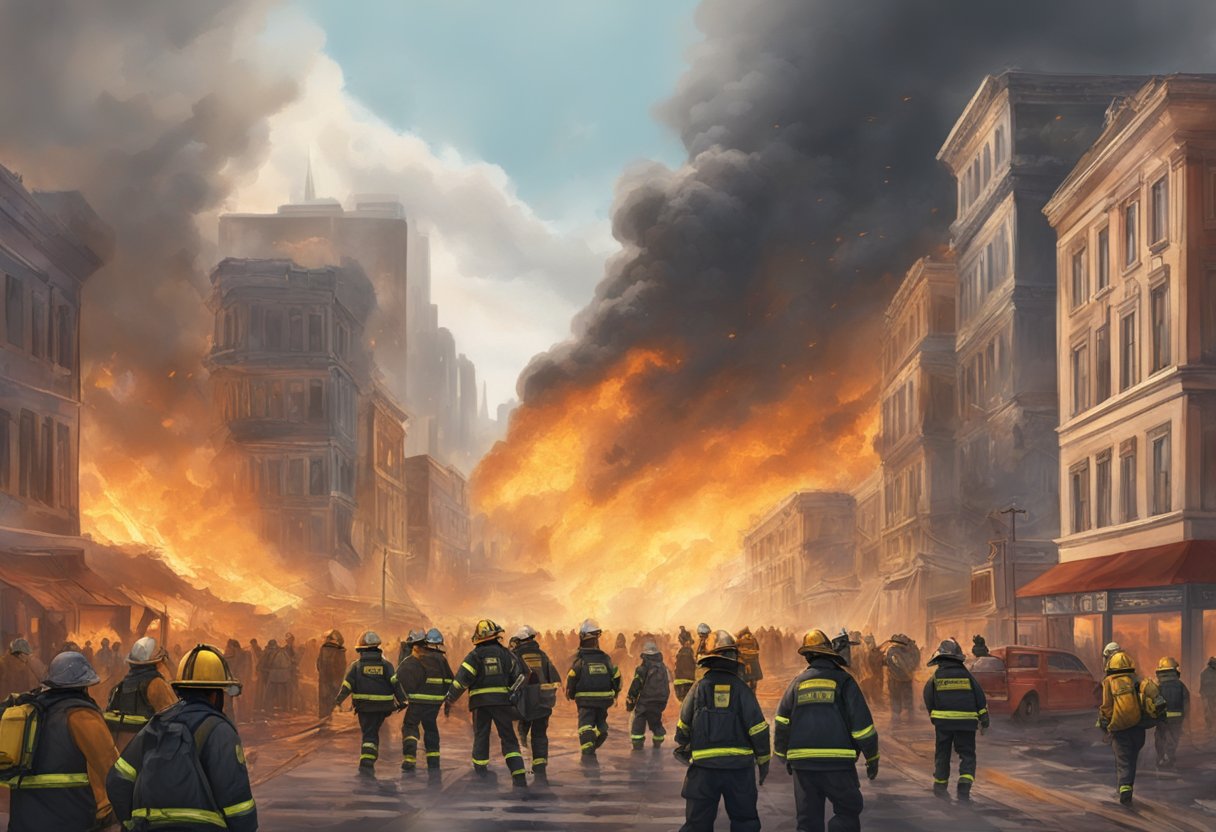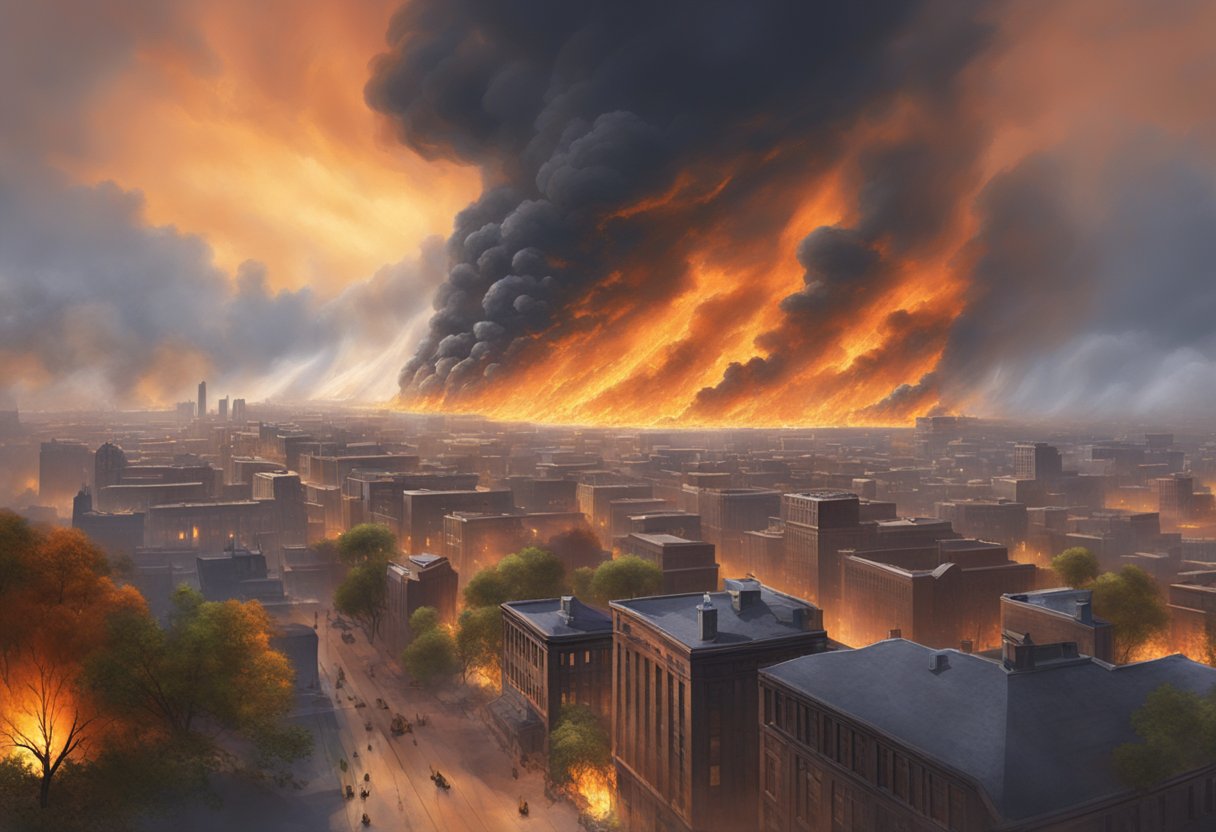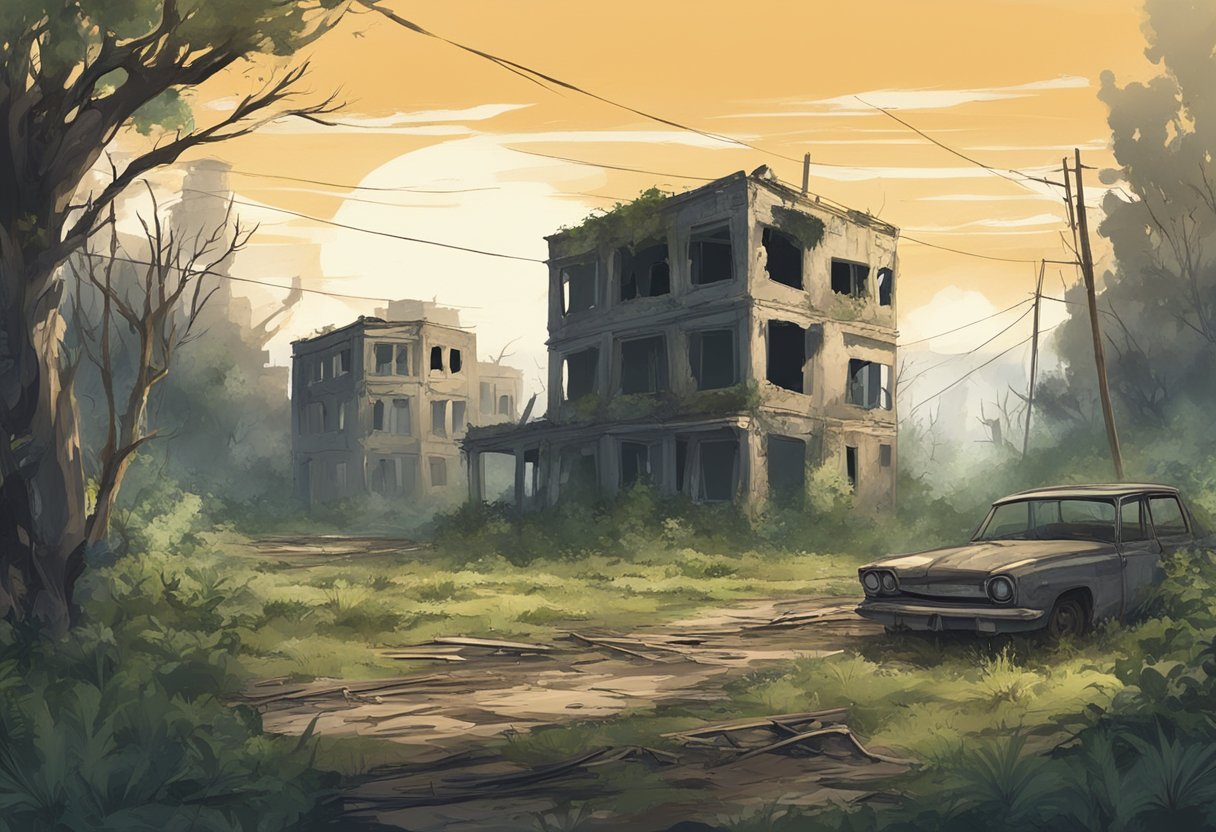The Great Fire of London Disaster: Rebuilding a City from Ashes

The Great Fire of London in 1666 was a catastrophe that forever changed the face of the city. Starting in a small bakery on Pudding Lane, the fire raged for four days, consuming 80% of London. The city was left in ruins, with over 13,000 houses, 87 parish churches, and iconic landmarks such as St. Paul’s Cathedral destroyed.
Though devastating, the disaster paved the way for a complete transformation of London. Amidst the ashes and despair, city planners saw an opportunity to rebuild stronger and more resilient. Brick and stone replaced timber and thatch, creating a city that could better withstand such disasters.
Even as the Great Fire wreaked havoc, it also sparked a period of innovation and renewal. Londoners faced the challenge of rebuilding with determination, leading to the creation of wider streets and more fire-resistant buildings. The resulting new city was not just rebuilt but reimagined, positioning London for future growth and development.
Prelude to the Catastrophe

The Great Fire of London in 1666 did not occur in isolation. It was precipitated by the dire conditions and vulnerabilities existing in the city.
The Year of Woes: 1665
In 1665, London was overwhelmed by the Great Plague, a deadly disease that killed up to 100,000 people. This health crisis left the city in a weakened state, struggling to cope with high mortality rates and immense fear.
People lived in close quarters, leading to overcrowded neighborhoods which were breeding grounds for disease. The economic impact was significant, with businesses failing and markets disrupted. This already strained the city's resources and infrastructure, setting a grim stage for any further disaster.
Urban Infrastructure Before the Fire
London in the 17th century was a maze of wooden buildings and houses with thatch roofs. The streets were narrow, making it easy for fire to travel quickly from one structure to another.
Building regulations were lax, and many homes were constructed with highly flammable materials. Firefighting methods were primitive, relying on buckets and fire hooks, which were ineffective in controlling large fires. This combination of factors made the city a tinderbox, primed for catastrophe.
Commencement of the Conflagration
The Great Fire of London began suddenly and spread quickly due to specific circumstances. The fire started in a bakery on Pudding Lane, and strong winds and wooden structures facilitated its rapid expansion.
Pudding Lane: Igniting the Disaster
In the early hours of September 2, 1666, a small fire started in Thomas Farriner's bakery on Pudding Lane. The bakery was part of a crowded street with many wooden buildings, which became easy fuel for the flames.
Farriner's bakery was a supplier for local businesses. The initial spark turned into an uncontrollable blaze, burning through the connected wooden structures. Attempts to douse the flames failed due to the limited firefighting methods of the time.
The location and structure of the bakery set the stage for a massive disaster. The combination of a densely packed area and highly flammable building materials meant the fire spread quickly, leaving little time for an effective response.
Rapid Spread: Wind and Wood
Once the fire began, strong easterly winds blew the flames towards the core of the city. This wind carried sparks across streets, setting new fires. The wooden buildings in London acted like kindling, making it difficult to contain the blaze.
The narrow streets and close proximity of houses allowed the fire to move from one building to another with ease. Roofs, walls, and floors made of timber ignited rapidly, causing entire blocks to burn at once.
Efforts to create firebreaks by demolishing houses proved ineffective against the fast-moving flames. The combination of wind and wood played a crucial role in amplifying the disaster, leading to widespread destruction in a short amount of time.
Chaos and Response

In 1666, as the Great Fire of London raged, the city faced immense chaos. People struggled to escape, while officials and residents desperately worked to control the flames.
The City Ablaze: Eyewitness Accounts
Samuel Pepys and John Evelyn, both famous diarists, recorded their experiences. Pepys described the heat and the noise of the fire, comparing it to the roar of a great furnace. Evelyn noted the fear and panic among the people. Buildings collapsed, and the sky turned dark with smoke.
People fled in all directions. Streets were crowded with citizens carrying their belongings. The River Thames was filled with boats, as those escaping tried to cross the water.
Efforts to Quell the Flames
Firefighters at the time used fire engines, which were primitive and ineffective. They relied mainly on buckets of water carried by hand. The strong wind spread the fire quickly, making their efforts even more challenging.
Officials ordered buildings to be demolished to create firebreaks. This was supposed to stop the fire from spreading further. Despite these efforts, the fire continued to rage for four days, destroying a large part of the city.
Escape and Survival
Many residents escaped by boat across the River Thames. The river became a vital escape route as the fire raced through the city. People sought shelter outside the city walls in fields and open areas.
Survival meant acting quickly. Many grabbed whatever they could carry and ran. Those with means took to the river, hoping to find safety on the other side. Reports mention thousands of displaced people, with the richer citizens able to transport more of their belongings by boat.
The destruction was vast, but the resilience of the survivors was notable. They were determined to rebuild and carry on despite the tremendous loss. Their efforts laid the foundation for the London we know today.
Impact of the Fire

The Great Fire of London in 1666 had a profound impact on the city, leading to immediate devastation and long-term societal changes. The fire caused significant loss of life, destruction of property, and fueled many rumors.
Death Toll and Direct Aftermath
The fire raged for four days, starting on September 2, 1666, in a bakery on Pudding Lane. It destroyed a vast portion of London, including 13,200 houses, 87 parish churches, and most civic buildings. Although the exact death toll remains unknown, it is believed to be relatively low compared to the scale of the destruction. The fire left 70,000 to 80,000 people homeless, forcing many to seek refuge in surrounding areas or temporary shelters.
Citizens worked tirelessly to escape the flames, often losing all their possessions in the process. St. Paul’s Cathedral, a landmark of the city, was burnt to its core. The air was filled with smoke and the stench of burning materials, creating a haunting atmosphere that lingered even after the fire was extinguished.
Societal Consequences and Rumours
The aftermath of the fire saw a city in turmoil. Rumors spread quickly, with accusations directed at various groups, particularly French, Dutch, and Catholics. These groups were suspected of starting the fire, leading to incidents of violence and persecution. The climate of fear and suspicion was exacerbated by the recent Anglo-Dutch Wars and existing religious tensions.
Homes and businesses had to be rebuilt from scratch, leading to substantial changes in urban planning. New building regulations were implemented to prevent future fires, including the use of fire-resistant materials like brick and stone instead of wood. The social fabric of London was forever altered, as the fire forced a rethinking of residential and commercial layouts.
The devastation also spurred advancements in firefighting techniques and the establishment of more organized firefighting services. Despite the chaos, the rebuilding efforts laid the groundwork for a more resilient and modern city.
Rebuilding London

The reconstruction of London after the Great Fire of 1666 involved detailed planning, key figures, and architectural changes. This period reshaped the city's landscape with new materials and regulations.
Reconstruction Plans and Regulations
After the fire, the Rebuilding of London Act was passed in February 1667. New buildings were required to be constructed with brick or stone to prevent future fire disasters. This marked a significant shift from timber to non-flammable materials.
The Act also limited the number of storeys per house to reduce overcrowding. Streets were widened, and the medieval system of Guilds was reviewed to adapt to the new urban layout. Rebuilding plans included specific guidelines to ensure safety and order.
Key Figures in the Rebuilding Effort
Christopher Wren and Robert Hooke were pivotal in the rebuilding process. Wren, a notable architect, and Hooke, a versatile scientist, both contributed their expertise. Wren designed many of the city's churches, including the iconic St. Paul's Cathedral, which became symbols of the city's resilience.
Hooke's contributions included designing street layouts and surveying the damage. Their combined efforts not only sped up the reconstruction but also ensured the city was rebuilt with a focus on functionality and beauty.
Architectural Transformation
The architectural landscape of London was transformed during the rebuilding. The use of brick and stone in construction created sturdier and more fire-resistant buildings. This period saw the end of medieval wooden houses and the birth of modern urban planning.
The city's skyline changed with the addition of new buildings designed by Wren and other architects. These buildings introduced a uniform look and feel, marking a new era in London's architectural history. The emphasis on safety and durability was a direct response to the devastation caused by the fire.
Legacy of the Fire
The Great Fire of London left a lasting impact on the city's architecture, culture, and historical memory. This section will explore its influence on modern perceptions and how it is remembered through cultural references and commemorations.
Modern Perception and Historical Significance
The fire's destructive power reshaped London. Historians note that the fire drastically changed building regulations and urban planning. Wooden houses gave way to brick and stone structures to prevent future fires.
The Monument, designed by Christopher Wren, stands as a reminder of the fire’s devastation and the city's resilience. It marks the point where the fire started and serves as a tribute to the rebuilding efforts.
The idea of the Mythical Phoenix rising from ashes is often used to symbolize London's resurgence. This image resonates with the city’s ability to recover and grow stronger after the disaster.
Cultural References and Commemoration
The Great Fire of London is a prominent theme in literature, art, and media. Writers, like Samuel Pepys in his famous diaries, captured the horror and chaos of those days.
Annually, historical reenactments and educational programs keep the memory alive for new generations. Events often take place at The Monument, drawing visitors who wish to learn about this critical period.
Artwork and films about the fire highlight the city’s journey from destruction to renewal. These cultural pieces commemorate the fire while emphasizing the resilience and strength of its people.
Architectural Heritage Post-Fire
The Great Fire of London in 1666 reshaped many aspects of the city’s architecture. Key buildings, such as churches and public buildings, were redesigned and rebuilt, reflecting both resilience and innovation.
Churches and Public Buildings
Many notable churches were affected by the Great Fire. St. Paul’s Cathedral was one of the most significant structures rebuilt. Designed by Sir Christopher Wren, the new cathedral became an iconic symbol of resilience. Its grand dome remains a landmark in London.
Other public buildings, like the Royal Exchange and Guildhall, also underwent significant reconstruction. The Royal Exchange, important for trade and commerce, was redesigned to handle increased activities. Guildhall, serving as the ceremonial and administrative center, was restored to maintain its historical significance.
In total, 87 churches were either completely rebuilt or heavily restored. The new designs often reflected Baroque influences, showcasing a blend of decorative detail and strong structural lines.
Surviving Structures of the Era
While the fire destroyed a large part of the city, some buildings miraculously survived. Parts of the City Walls, dating back to Roman times, remained intact. These ancient structures provided a historical backdrop amidst the new architecture.
Areas outside the fire's reach preserved pre-1666 buildings. These surviving structures offer a glimpse into the architectural style before the disaster. They include various small houses and shops that were built using traditional timber framing.
The fire also led to new regulations for building materials, emphasizing brick and stone over wood. This change aimed to prevent future disasters, leading to a more fire-resistant city layout.
In essence, the architectural heritage post-fire showcases a blend of survival and renewal, highlighting both historical resilience and forward-looking innovation.




